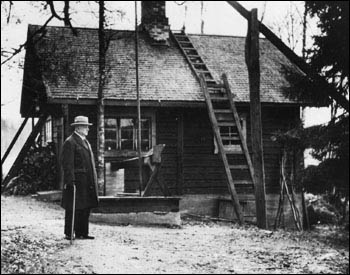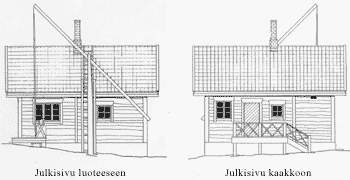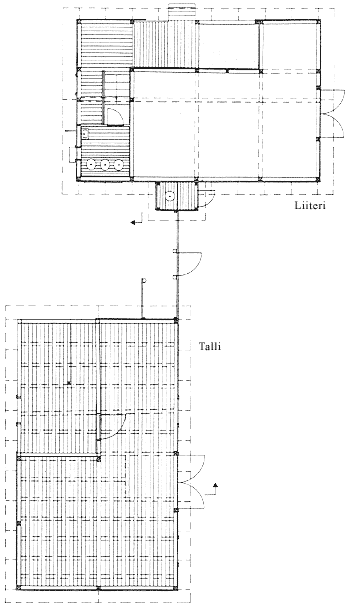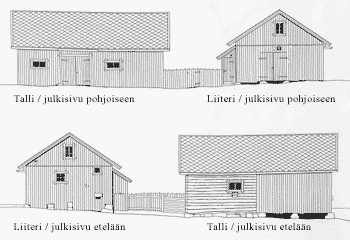The shed 1904
The shed with its outside toilet was erected at the same time as the main building. Ainola was wood-heated up until the 1960s. The shingle roof of the shed was covered over with tiles in 1932 at the same time as the main building.
Sauna 1905

Jean Sibelius and his renovated sauna in 1927.

In February 1905 Sibelius was happy because of the publishing contract he had signed with Robert Lienau in Berlin. He would gain extra earnings equivalent to almost 34,000 euros if he could compose four major works per year. Sibelius wrote to his wife: "We have had such sad years now for 10 years! At least now it is certain! I am going to build a sauna. Tell Laine! He can start hauling the logs!"
The red-ochred sauna with its shingle roof was erected according to the instructions of Aino Sibelius at the southernmost point of the grounds, in the late summer of 1905. The sauna had a dressing room and a laundry room. Water came from a well next to the sauna and flowed along an inclined channel designed by Aino herself. Rikhard Laine built the sauna with the help of seven carpenters, one bricklayer and the neighbour's horse. The Sibeliuses could bathe in their sauna at the end of October. The total costs of the construction equalled the "remuneration for one major work" as set out in Sibelius's publishing contract, i.e. almost 9000 euros. The sauna was renovated in the mid-1920s under the supervision of the builder Aarne Männikkö. The tile roof was built in 1932.
The stable in 1912


The Sibeliuses needed a horse to transport people and goods from Järvenpää station and to take manure to the vegetable garden. Up until 1911 they had hired the horse of their neighbour, the novelist Juhani Aho, but when the Aho family moved to Helsinki, the Sibeliuses had to build a stable and buy a horse. The shingle-roof stable was completed in the early summer of 1912. A sty for a pig (named "Ottiilia") was built behind the stable a couple of years later. In August 1912 Sibelius bought a horse, Vilkku, from agronomist Lennart Hagelstam, the owner of Hinthaara Manor. Sibelius's daughter Ruth recollected later that the horse was bought at Östersundom Manor, which was near where Hagelstam had lived previously.
Ruth also rode on Vilkku, until the ill-tempered horse threw her off its back causing concussion and temporary amnesia. The horse was sold in 1918 due to a lack of fodder.
During the 1910s the stable was also used as a henhouse. In 1914 the masters of the henhouse were three white cocks: Matti, Pekka and Mikko. Sibelius once grabbed one of them from the yard and took it inside the house to cheer up the children. "We tried to stroke it and we were amused and delighted. It made us forget the dreariness of the rainy day," his daughter Katarina recollected later.
The playhouse in the early 1910s
The children's playhouse was built in the early 1910s for "the snow buntings", i.e. Margareta and Heidi. It was built in the shade of a tall spruce along the path which today leads to the grave. At Christmas 1915 the original playhouse was replaced by a new factory-made playhouse from Kerava furniture factory.
The building housing the café, the ticket desk and the caretaker's lodgings at Ainola in 1974
The present entrance and maintenance building was built in 1974 on the site of the former tennis court. The building was designed by Sibelius's son-in-law, the architect Aulis Blomstedt.









